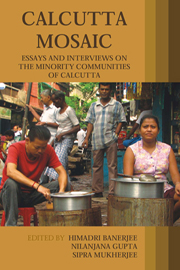Book contents
- Frontmatter
- Contents
- List of Contributors
- Acknowledgements
- Introduction
- 1 Mapping the Spaces of Minorities
- 2 The Armenians of Calcutta
- 3 The Jews of Calcutta: An Interview with Michael Ezra
- 4 The Sindhis of Calcutta
- 5 The City of Colleges
- 6 The Chinese Community of Calcutta
- 7 The Anglo–Indians of Calcutta
- 8 The Biharis of Calcutta
- 9 Agraharis of Calcutta
- 10 A Journey into My Neighbourhood
- 11 The ‘South Indians’ of Calcutta: Experiences in Cultural Processes
- 12 ‘Non-Bengali’ Icons of Malevolence
- 13 Selfing the City
2 - The Armenians of Calcutta
Published online by Cambridge University Press: 05 March 2012
- Frontmatter
- Contents
- List of Contributors
- Acknowledgements
- Introduction
- 1 Mapping the Spaces of Minorities
- 2 The Armenians of Calcutta
- 3 The Jews of Calcutta: An Interview with Michael Ezra
- 4 The Sindhis of Calcutta
- 5 The City of Colleges
- 6 The Chinese Community of Calcutta
- 7 The Anglo–Indians of Calcutta
- 8 The Biharis of Calcutta
- 9 Agraharis of Calcutta
- 10 A Journey into My Neighbourhood
- 11 The ‘South Indians’ of Calcutta: Experiences in Cultural Processes
- 12 ‘Non-Bengali’ Icons of Malevolence
- 13 Selfing the City
Summary
Calcutta has, since its origin and at different points in time, always allured people. Because of its strategic, geographic and commercial position, along with various historical, economic and political reasons, people from not only numerous corners of the country and the neighbouring states, but also from far off places, have come to the city. Alongside internal migration, there has always been a kaleidoscopic inflow of people from distant lands. Particularly since its emergence as the capital of British India and as the centre for trade of entire South-East Asia and China, a deluge of international immigrants like Dutch, French, Jews, Chinese and Armenians have given the city its cosmopolitan character. Hence, the city has always portrayed itself as a mosaic of a large number of diverse ethnic groups, who had set their foot on this land of opportunities in search of fate and fortune, having different cultures, languages and religions.
The existence of the Armenian community in Calcutta came into the limelight recently when His Holiness Karekin II, Supreme Patriarch and Catholicos of All Armenians, as a part of His 10-days (23 February–4 March 2007) Pontifical Visit to India, came down from Etchmiadzin in Armenia to meet and bless the Indian–Armenian diaspora of the city. This was after more than 40 years since His Holiness Vazgen I, the Catholicos from 1955–1994, visited the country in 1963, when the foundation stone of the present building of the Armenian College was laid on 9 December of that year.
- Type
- Chapter
- Information
- Calcutta MosaicEssays and Interviews on the Minority Communities of Calcutta, pp. 71 - 86Publisher: Anthem PressPrint publication year: 2009



